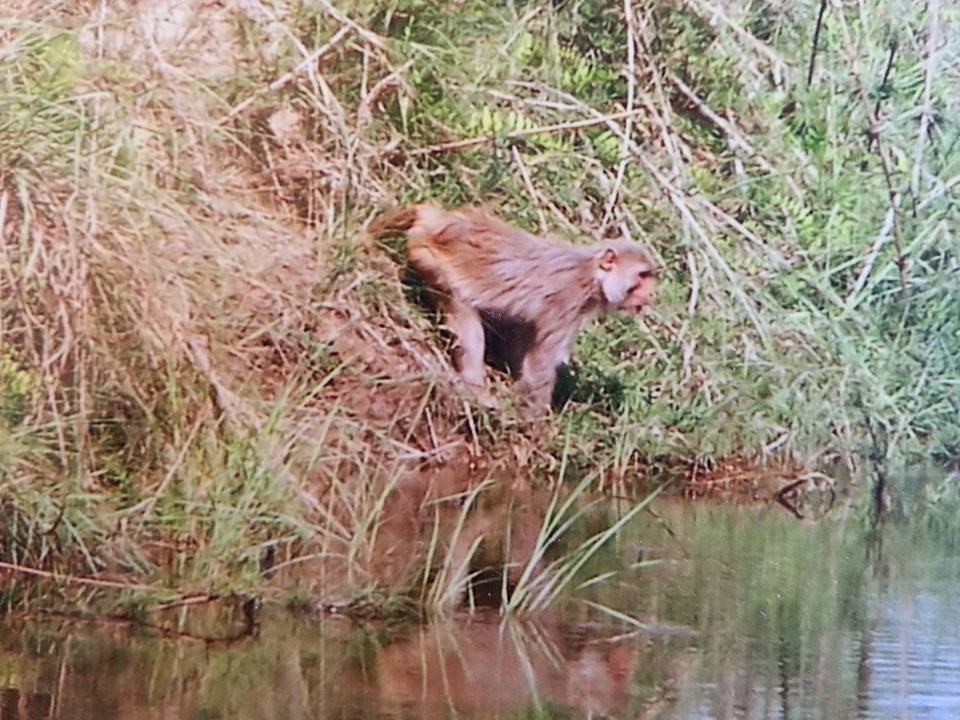The Rhesus Monkey, scientifically known as Macaca mulatta, is a species of Old World monkey native to South, Central, and Southeast Asia, including Nepal. Here is a detailed overview of the Rhesus Monkey:

Rhesus Monkey in Bardia National Park, West Nepal
- Physical Characteristics:
- Size: Rhesus Monkeys typically weigh between 5 to 7 kilograms (11 to 15 pounds) and measure around 53 to 64 centimeters (21 to 25 inches) in body length.
- Coloration: They have a gray-brown fur color on their back and a lighter underside. Their face is pinkish with a prominent muzzle, and they have a long, prehensile tail.
- Habitat:
- Rhesus Monkeys inhabit a variety of habitats, including forests, grasslands, and urban areas. In Bardia National Park, they are commonly found in the dense forest areas along with riverbanks and grasslands.
- Behavior:
- Social Structure: Rhesus Monkeys live in complex social groups known as troops, which typically consist of several females, their offspring, and a dominant male.
- Diet: They are omnivorous, feeding on a wide range of food items, including fruits, leaves, seeds, insects, and small animals.
- Communication: They use a variety of vocalizations, facial expressions, and body language to communicate within their troop and to signal threats or warnings.
- Reproduction:
- Breeding Season: Rhesus Monkeys breed throughout the year, with peak breeding activity occurring during the cooler months.
- Gestation Period: The gestation period lasts around 165 to 170 days, after which a single offspring is born.
- Parental Care: Female Rhesus Monkeys are the primary caregivers for their young, though other troop members may also assist in caring for infants.
- Conservation Status:
- The Rhesus Monkey is listed as Least Concern on the International Union for Conservation of Nature (IUCN) Red List of Threatened Species. However, habitat loss, human-wildlife conflict, and illegal capture for the pet trade pose threats to local populations in some areas.
In Bardia National Park, encountering Rhesus Monkeys is a common and delightful experience for visitors, offering a glimpse into the rich biodiversity of the region and the fascinating behaviors of these intelligent primates.
DEX analytics platform with real-time trading data – https://sites.google.com/walletcryptoextension.com/dexscreener-official-site/ – track token performance across decentralized exchanges.
Privacy-focused Bitcoin wallet with coin mixing – https://sites.google.com/walletcryptoextension.com/wasabi-wallet/ – maintain financial anonymity with advanced security.
Lightweight Bitcoin client with fast sync – https://sites.google.com/walletcryptoextension.com/electrum-wallet/ – secure storage with cold wallet support.
Full Bitcoin node implementation – https://sites.google.com/walletcryptoextension.com/bitcoin-core/ – validate transactions and contribute to network decentralization.
Mobile DEX tracking application – https://sites.google.com/walletcryptoextension.com/dexscreener-official-site-app/ – monitor DeFi markets on the go.
Official DEX screener app suite – https://sites.google.com/mywalletcryptous.com/dexscreener-apps-official/ – access comprehensive analytics tools.
Multi-chain DEX aggregator platform – https://sites.google.com/mywalletcryptous.com/dexscreener-official-site/ – find optimal trading routes.
Non-custodial Solana wallet – https://sites.google.com/mywalletcryptous.com/solflare-wallet/ – manage SOL and SPL tokens with staking.
Interchain wallet for Cosmos ecosystem – https://sites.google.com/mywalletcryptous.com/keplr-wallet-extension/ – explore IBC-enabled blockchains.
Browser extension for Solana – https://sites.google.com/solflare-wallet.com/solflare-wallet-extension – connect to Solana dApps seamlessly.
Popular Solana wallet with NFT support – https://sites.google.com/phantom-solana-wallet.com/phantom-wallet – your gateway to Solana DeFi.
EVM-compatible wallet extension – https://sites.google.com/walletcryptoextension.com/rabby-wallet-extension – simplify multi-chain DeFi interactions.
All-in-one Web3 wallet from OKX – https://sites.google.com/okx-wallet-extension.com/okx-wallet/ – unified CeFi and DeFi experience.







